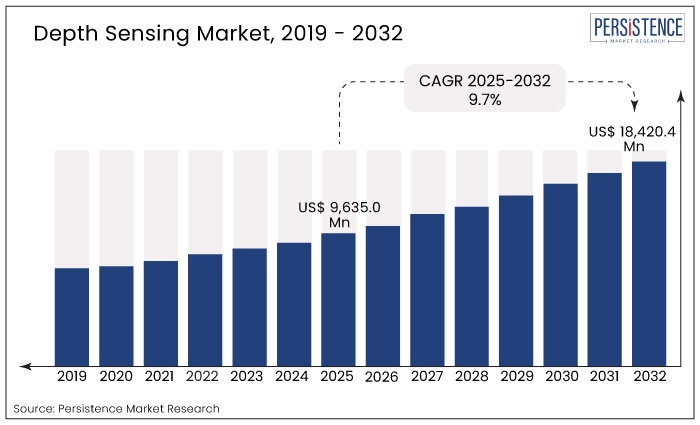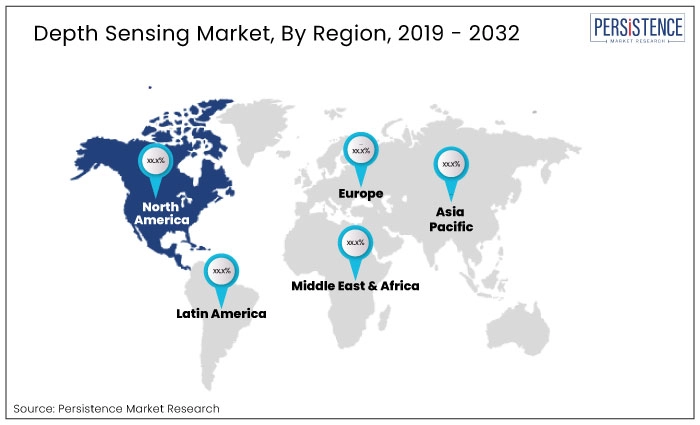ID: PMRREP33442| 198 Pages | 15 Jul 2025 | Format: PDF, Excel, PPT* | Semiconductor Electronics

According to PMR, the global market for depth sensing will likely reach US$ 9,635.0 Million by 2025. The market is projected to reach US$ 18,420.4 Million by 2032. During the 2025 to 2032 forecast period, the market is poised to expand at a CAGR of 9.7%.
A wide range of applications for depth sensing across different industries are expected to drive the global market forward. A variety of applications rely on depth sensors. Unmanned robotic vehicle navigation systems, multipoint depth sensors, people counting, and other machine interfaces are included under this classification.
Computer vision (CV) and deep learning technology continue to advance in both hardware and software. The understanding of innovations involving depth sensors is key to their future development.
For instance, the Schnalstal/Senales Valley is testing new satellite technology to measure snow thermal conductivity. Traditionally, snow density and depth have been monitored using satellite images.
With technological advancements, the demand for depth sensing is increasing in the medical industry. According to researchers at the University of Hong Kong, remote sensing of photoacoustic signals can be used to image biological tissue more sensitively than conventional photoacoustic imaging.

Using noncontact photoacoustic remote sensing microscopy (PARS), the researchers demonstrated near-infrared (NIR), noncontact imaging of lipids. PARS provided a high signal-to-noise ratio, a wide detection bandwidth, and deep penetration depth for imaging biological samples, as well as noncontact implementation.
| Report Attributes | Details |
|---|---|
|
Depth Sensing Market Size (2025) |
US$ 9,635.0 Million |
|
Depth Sensing Projected Market Value (2032) |
US$ 18,420.4 Million |
|
Depth Sensing Market CAGR (2025 to 2032) |
9.7% |
According to Persistence Market Research (PMR), the depth sensing market is projected to grow at a 9.7% CAGR from 2025 to 2032. Over the historical period of 2019 to 2024, the market recorded a 7.0% CAGR.
Increasing facial recognition and gesture control capabilities will increase smartphone demand significantly. It will lead to a boost in the global depth sensing industry. As LiDAR is increasingly used to detect obstacles in front and behind vehicles, the automotive application segment is expected to grow substantially during the forecast period.
Robotics, electronics, automation, surveillance, defense, and motion detectors are likely to boost growth in the future. Defense and military sectors also utilize depth sensing technology. A surveillance system is used by the military to monitor enemy activity and surveil them. Therefore, depth sensing demand will increase with increasing adoption throughout the defense & military industries.
New Technologies and the Adoption of AI to Open Opportunistic Growth Frontiers
The popularity of AR/VR technology and the growing demand for smartphones will drive the depth sensing market forward. With self-driving cars getting more attention in the future, demand is expected to continue to grow in the coming years. Smartphone manufacturers are increasingly using 3D cameras as an alternative to costly laser scanners.
Increasing demand for smart homes, surveillance, and security systems is expected to drive market growth in the coming years. Gaming applications are increasingly incorporating depth-sensing technology, which is driving the growth of depth-sensing markets worldwide. Advanced nanotechnology-based sensors are employed more in industrial applications; the market is expected to grow rapidly.
LiDAR technology is becoming more widely used, and this has created growth prospects for the market. It is anticipated that 3D depth sensors will increase in popularity across various industries in the coming years. Mobile phones are gaining popularity due to rapid digitalization and 5G technology penetration. With smartphones integrating depth-sensing technologies, the global depth-sensing market will continue to grow.
What is the Growth Outlook for the North American Depth Sensing Market?
Expansion of Electronics and Elevating Automotive Sectors to expand Demand
According to PMR, North America will dominate the global depth sensing market. The North American market for depth sensing is predicted to reach US$ 6.03 billion by 2032. A market share of 40.2% is predicted for the depth sensing market in North America in 2024.
With the increased investment and adoption of IoT technology by companies, the region is expected to continue dominating the market over the forecast period. The auto industry and consumer electronics industries, in particular, are benefiting from technological advancements in the North American region.
The United States is expected to yield 78% of the global market revenues by 2024. The country is expected to grow to US$ 2.3 billion, rising at a CAGR of 7% by 2032. The use of depth sensing technology to drive growth in both the defense and consumer electronics industries. The growing adoption of high-speed internet, smart devices, and digitization is driving demand for smart devices.
Artificial intelligence and robotics are adopted more widely in the industrial sector; the United States market will continue to grow. Technological advancements and increased sensor adoption in the United States have led to a growth rate for this region.

What makes Depth Sensing So Popular in the Asia Pacific?
Government initiatives will increase the demand for Depth Sensing in Asia Pacific Region
The depth sensing market in the Asia Pacific will accumulate a revenue share of 24.6% in 2024. China, India, and Japan are home to many consumer electronics and automotive manufacturing plants that are growing rapidly. Deep sensing cameras are key to bringing advanced sensors to this region.
According to the forecast, China will reach US$ 1.2 billion by the end of the forecast period. Between 2025 and 2032, PMR anticipates that the market will hold a market share of approximately 35% and reach US$ 500 million in 2024.
The Chinese market is the world's largest manufacturer of smartphones. About 15% of the world's smartphone users are located in the country. As demand for smartphones increases, the production of smartphones will accelerate in China in the coming years. It will boost sales of depth sensors in the country, which will contribute to the expansion of the depth-sensing industry. An increase in the use of depth sensing in the automotive industry and rapid growth in the medical field. As autonomous vehicles develop, companies that provide depth sensing will gain opportunities.
Which Component will drive the Global Depth Sensing Market?
High Consumer Interest in Camera/Lens Module Dominates the Market for Depth Sensing
The camera/lens module market is projected to grow at a CAGR of 8.1% by 2032. The camera/lens module will continue to dominate the market in terms of revenue. Cameras and lenses with depth sensors are being increasingly adopted in a wide range of applications.
Due to the increasing popularity of 3D imaging and high-quality pictures, a demand for camera/lens modules is expected to grow. The increasing penetration of facial recognition technology on smartphones, smart homes, and security systems has also contributed to the growth of this market.
The use of nonsterile technology in the operating room (OR) is becoming increasingly important as surgical procedures become more dependent on equipment and imaging.
Studies are also focusing on investigating whether touchless gestural interfaces are effective and cost-effective in different surgical procedures. The use of depth-sensing cameras has become increasingly common since the release of Microsoft's Kinect gaming controller.
Researchers at Carnegie Mellon University and the University of Toronto have developed a new imaging technology to solve a major problem with these cameras. A depth-detecting camera invented by CMU and Toronto University is able to capture 3-D information even in bright lighting. Using prototype technology, an LED bulb can be discerned, causing a blinding glare when viewed through a conventional camera.
Which Technology will drive Demand for Depth Sensing in the Market?
Time-of-Flight are expected to Grow Steadily During the Forecast Period
By technology, the depth sensing market is segmented into stereo vision, structured light, and time-of-flight. Within the next couple of years, time-of-flight is expected to dominate the depth sensing market.
With low power consumption, high accuracy, and relatively simple hardware and software requirements, time-of-flight technology has seen rapid growth in the depth sensing market.
For instance, May 2023, Infineon and pmdtechnologies' 3D depth-sensing technology for Magic Leap 2 will enable cutting-edge industrial and medical applications. Magic Leap 2 has demonstrated the potential of the REAL3TM 3D Image Sensor. Through the new and upgraded IRS2877C Time-of-Flight imager, the device can recognize and respond to the user's physical environment.
Deep sensing manufacturers are forming strategic partnerships with technology firms. As the organization grows its product line, technological capabilities, and marketing presence, it hopes to capture a greater share of the market. The development of innovative products could be achieved by combining the strengths of different companies.
Many companies improve their products through research and development. Gaining a competitive advantage can also be achieved by introducing new products.
The market is expected to reach US$ 18,420.4 Million by 2032.
The market is projected to grow at a CAGR of 9.7% during the forecast period.
North America is expected to lead, with a 40.2% market share in 2024.
Leading players include Texas Instruments, Intel, Infineon, Qualcomm, and Sony Depthsensing Solutions.
Key sectors include automotive, consumer electronics, industrial, and medical.
| Attribute | Details |
|---|---|
|
Forecast Period |
2025 to 2032 |
|
Historical Data Available for |
2019 to 2024 |
|
Market Analysis |
Value: US$ Mn, Volume: Units |
|
Key Countries Covered |
|
|
Key Market Segments Covered |
|
|
Key Companies Profiled |
|
|
Customization & Pricing |
Available upon Request |
By Component:
By Type:
By Technology:
By Vertical:
By Region:
Delivery Timelines
For more information on this report and its delivery timelines please get in touch with our sales team.
About Author